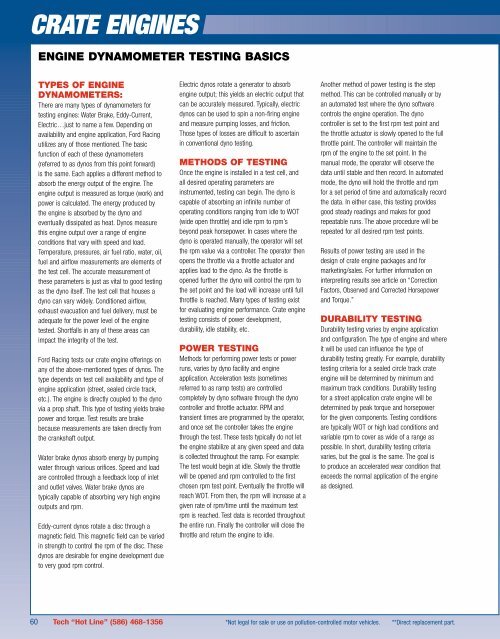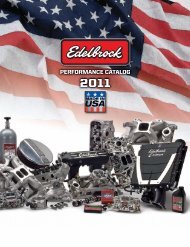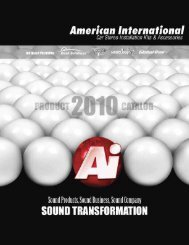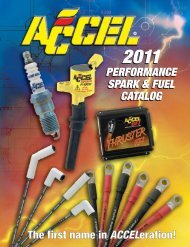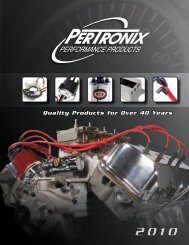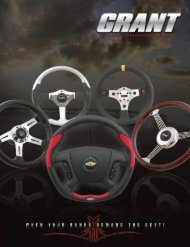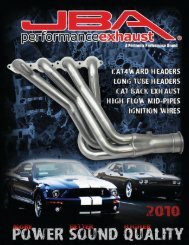2006 Ford Racing Performance Parts Catalog - Chromwerk
2006 Ford Racing Performance Parts Catalog - Chromwerk
2006 Ford Racing Performance Parts Catalog - Chromwerk
Create successful ePaper yourself
Turn your PDF publications into a flip-book with our unique Google optimized e-Paper software.
CRATE ENGINES<br />
ENGINE DYNAMOMETER TESTING BASICS<br />
TYPES OF ENGINE<br />
DYNAMOMETERS:<br />
There are many types of dynamometers for<br />
testing engines: Water Brake, Eddy-Current,<br />
Electric…just to name a few. Depending on<br />
availability and engine application, <strong>Ford</strong> <strong>Racing</strong><br />
utilizes any of those mentioned. The basic<br />
function of each of these dynamometers<br />
(referred to as dynos from this point forward)<br />
is the same. Each applies a different method to<br />
absorb the energy output of the engine. The<br />
engine output is measured as torque (work) and<br />
power is calculated. The energy produced by<br />
the engine is absorbed by the dyno and<br />
eventually dissipated as heat. Dynos measure<br />
this engine output over a range of engine<br />
conditions that vary with speed and load.<br />
Temperature, pressures, air fuel ratio, water, oil,<br />
fuel and airflow measurements are elements of<br />
the test cell. The accurate measurement of<br />
these parameters is just as vital to good testing<br />
as the dyno itself. The test cell that houses a<br />
dyno can vary widely. Conditioned airflow,<br />
exhaust evacuation and fuel delivery, must be<br />
adequate for the power level of the engine<br />
tested. Shortfalls in any of these areas can<br />
impact the integrity of the test.<br />
<strong>Ford</strong> <strong>Racing</strong> tests our crate engine offerings on<br />
any of the above-mentioned types of dynos. The<br />
type depends on test cell availability and type of<br />
engine application (street, sealed circle track,<br />
etc.). The engine is directly coupled to the dyno<br />
via a prop shaft. This type of testing yields brake<br />
power and torque. Test results are brake<br />
because measurements are taken directly from<br />
the crankshaft output.<br />
Water brake dynos absorb energy by pumping<br />
water through various orifices. Speed and load<br />
are controlled through a feedback loop of inlet<br />
and outlet valves. Water brake dynos are<br />
typically capable of absorbing very high engine<br />
outputs and rpm.<br />
Eddy-current dynos rotate a disc through a<br />
magnetic field. This magnetic field can be varied<br />
in strength to control the rpm of the disc. These<br />
dynos are desirable for engine development due<br />
to very good rpm control.<br />
Electric dynos rotate a generator to absorb<br />
engine output; this yields an electric output that<br />
can be accurately measured. Typically, electric<br />
dynos can be used to spin a non-firing engine<br />
and measure pumping losses, and friction.<br />
Those types of losses are difficult to ascertain<br />
in conventional dyno testing.<br />
METHODS OF TESTING<br />
Once the engine is installed in a test cell, and<br />
all desired operating parameters are<br />
instrumented, testing can begin. The dyno is<br />
capable of absorbing an infinite number of<br />
operating conditions ranging from idle to WOT<br />
(wide open throttle) and idle rpm to rpm’s<br />
beyond peak horsepower. In cases where the<br />
dyno is operated manually, the operator will set<br />
the rpm value via a controller. The operator then<br />
opens the throttle via a throttle actuator and<br />
applies load to the dyno. As the throttle is<br />
opened further the dyno will control the rpm to<br />
the set point and the load will increase until full<br />
throttle is reached. Many types of testing exist<br />
for evaluating engine performance. Crate engine<br />
testing consists of power development,<br />
durability, idle stability, etc.<br />
POWER TESTING<br />
Methods for performing power tests or power<br />
runs, varies by dyno facility and engine<br />
application. Acceleration tests (sometimes<br />
referred to as ramp tests) are controlled<br />
completely by dyno software through the dyno<br />
controller and throttle actuator. RPM and<br />
transient times are programmed by the operator,<br />
and once set the controller takes the engine<br />
through the test. These tests typically do not let<br />
the engine stabilize at any given speed and data<br />
is collected throughout the ramp. For example:<br />
The test would begin at idle. Slowly the throttle<br />
will be opened and rpm controlled to the first<br />
chosen rpm test point. Eventually the throttle will<br />
reach WOT. From then, the rpm will increase at a<br />
given rate of rpm/time until the maximum test<br />
rpm is reached. Test data is recorded throughout<br />
the entire run. Finally the controller will close the<br />
throttle and return the engine to idle.<br />
Another method of power testing is the step<br />
method. This can be controlled manually or by<br />
an automated test where the dyno software<br />
controls the engine operation. The dyno<br />
controller is set to the first rpm test point and<br />
the throttle actuator is slowly opened to the full<br />
throttle point. The controller will maintain the<br />
rpm of the engine to the set point. In the<br />
manual mode, the operator will observe the<br />
data until stable and then record. In automated<br />
mode, the dyno will hold the throttle and rpm<br />
for a set period of time and automatically record<br />
the data. In either case, this testing provides<br />
good steady readings and makes for good<br />
repeatable runs. The above procedure will be<br />
repeated for all desired rpm test points.<br />
Results of power testing are used in the<br />
design of crate engine packages and for<br />
marketing/sales. For further information on<br />
interpreting results see article on “Correction<br />
Factors, Observed and Corrected Horsepower<br />
and Torque.”<br />
DURABILITY TESTING<br />
Durability testing varies by engine application<br />
and configuration. The type of engine and where<br />
it will be used can influence the type of<br />
durability testing greatly. For example, durability<br />
testing criteria for a sealed circle track crate<br />
engine will be determined by minimum and<br />
maximum track conditions. Durability testing<br />
for a street application crate engine will be<br />
determined by peak torque and horsepower<br />
for the given components. Testing conditions<br />
are typically WOT or high load conditions and<br />
variable rpm to cover as wide of a range as<br />
possible. In short, durability testing criteria<br />
varies, but the goal is the same. The goal is<br />
to produce an accelerated wear condition that<br />
exceeds the normal application of the engine<br />
as designed.<br />
60 Tech “Hot Line” (586) 468-1356 *Not legal for sale or use on pollution-controlled motor vehicles. **Direct replacement part.


